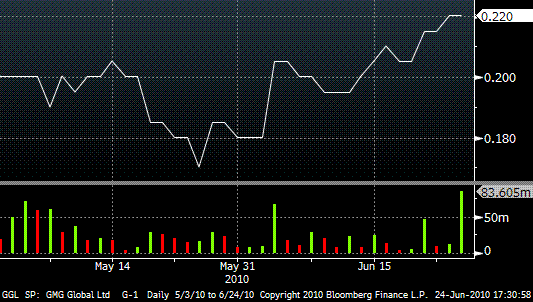
GMG’S STOCK price has surged steadily by 22% ever since the Royal Bank of Scotland initiated its ‘Buy’ call on the rubber plantation owner 3 weeks ago on 2 Jun.
It was the second most heavily traded stock today, with 83.6 million shares changing hands. The closing price was 22 cents, unchanged from the previous day, but there is still a 23% upside to RBS’ 27-cent target.
The earnings of GMG is directly related to rubber prices and crop yield.
And the outlook for the rubber market is so bright that RBS is forecasting that GMG will be able to double its year-on-year earnings in 2011 due to rising rubber prices and increased volumes.
About 70% of natural rubber produced worldwide is used to make tires.
RBS analyst Tiruchelvam is forecasting a 7% increase in demand for tires in China and India, where there is socio-economic shift of upgrading from bicycles to tricycles to motor automobiles, as well as the rise of heavy transport vehicles.

The analyst expects both India and China to see up to 10% in tire demand growth over 2010-12.
Other than demand from a growing number of automobiles, rising oil prices have driven up the price of synthetic rubber, which is manufactured from petroleum derivatives.
RBS economists forecast oil prices to remain around US$75 per barrel in 2010, rise steadily to more than US$80 per barrel in 2011 and more than US$90 per barrel in 2012.
Oil inventories are expected to fall as the global economy recovers.
As a result, many companies are switching back to natural-rubber products owing to their cheaper manufacturing costs.
Secondly, supply growth is likely to decline due to historic under-investment.
According to RBS estimates, the average age of the plantations was 15 years in 1980, which is the peak production age.
It estimates that the average age of the rubber crop is 21 years now, which is past the peak and therefore surmises that crop yield is will be on a downward trend.
This shortage is unlikely to end in the next three years due as rubber has a long gestation period of seven years, which is part of the reason why farmers have shied from investing in immature plantations.
”Rubber cycles are long and we may be at the early stage of a bull market,” said the analyst.
”We expect average prices of US$4,000 per ton in 2010, US$4,500 per ton in 2011 and US$5,000 per ton in 2012.”
|
The analyst highlighted that GMG Global is the only listed pure natural rubber play in the world.
Even though it has a high PE (currently 25 times for FY2010 based on RBS forecasts), its FY2011 earnings growth is forecasted to be 74% versus 34% for peers under RBS coverage.
The two other listed rubber planters are Kuala Lumpur Kepong and Perusahaan Perkebunan London Sumatra, but the analyst says less than 25% of the operating earnings of these two companies come from rubber as they mainly produce crude palm oil.
Risks to GMG’s investment story include:
1) the commercialization of a natural rubber substitute
2) depreciation in the USD, in which its contracts are denominated
3) a collapse in oil prices, which will lower the cost of producing synthetic rubber
Related story: GMG: S$100-m rights issue as rubber prices recover



